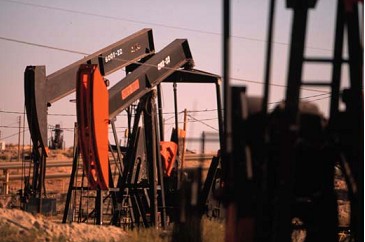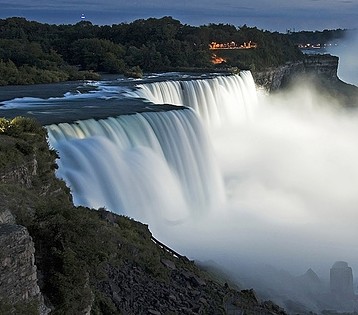Feb
3
Chevron Challenges Peak Oil
February 3, 2009 | 3 Comments
The oil people tend to think that “peak oil” is a strange concept. With the innovation, management skills and capital at hand there is good reason to think they are right. Which is not to say that peak oil can become real due to the absence of the very same qualities.
The graph above is a plot of the production from the Kern River field in the south end of the San Joaquin Valley in California. The American Petroleum Institute had blog writers out for a tour, expenses paid by the API again, to show the progress that Chevron has made over the years in enhanced recovery. The morning and the early part of the afternoon were filled with presentations from SAFETY to start and then history through to the management effort using technologies to run such a compact, complex and energy dense little place.
I mean little place, too. When you think of oil fields the impression comes of vast areas with wellheads and pumping machinery spread to the horizon and beyond. That’s a valid impression and is true for much of the production on land. But in a few places the oil below ground is located so condensed that the wells are but yards apart.
The well count is over 9000 for oil pumping, over 800 to inject steam and more than 650 wells for observation. There are a lot of little holes in the ground for something less than 13 square miles. One well is just 18 foot lengths from the door of the conference building.
What stands out is that Kern River is 110 years old. Over the years the production has increased far above the early rates. Now granted these are not such deep wells, and the oil is thick and heavy that is deposited into sands that barely qualify as rock. It’s as great a place for extracting oil as any; perhaps the best place to learn how extraction will increase worldwide.
The picture above is a road cut through a hill that shows the oil filled rock in strips. Two strips are visible. To get an idea of the volume of oil at Kern River, just one of eight fields in the south end of the San Joaquin Valley, has yielded 2 billion barrels of oil. That’s 84 billion gallons or more than 46 hours of flow over Niagara Falls.
The geologists and engineers think that with todays know how that more than another billion barrels can be recovered. That will still leave nearly a billion barrels below ground. There is a lot of oil. The question is at what price can it be recovered and sold?
The striking thing about management at Chevron is that to get the heat to make steam they use natural gas. But before they make steam, they use the gas to generate 17% of California’s base electrical power. Then they make steam. Which comes to an 80% efficiency of the natural gas itself. In return they get paid for the electricity, and sell much more energy dense oil. I doubt that Californians realize that for a great part of the base load they are getting an extremely good deal. These gas fired electrical turbines are decades old on long term, way low priced contracts for electricity. Plus California gets a steady base oil supply to fuel all those cars. Chevron even cleans the water that comes with the oil and sells it for irrigating food crops sent all across America.
The API has promised that the presentations might come with audio for posting sometime over the next few days. There was a camera crew on the tour through the field and Jeff Hatlen gives thoughtful, professional and technically adept guided commentary that gives a complete sense of what the field does and how its done. I’m sure hoping that the video crew’s work turned out, but early reports have it that there was radio frequency interference while out there. So there are more posts to come as information becomes available.
The other bloggers who made the trip are Bruce McQuain of QandO, Gail Tverberg from the OilDrum, and Joy McCann from LittleMissAttila. The API representative is Jane Van Ryan backed up by Jenn Lore and Sarah Hogeboom from Edelman, the Chevron Media people are Carla Musser, Justin Higgs and Alex Yelland.
The field people, the really interesting people who gave presentations and explain the information important to know are Jim Swartz, Omar Saleen, Neil Burgess, Kevin Kimber, Dale Beeson, Ray Thavarajah, David Burroughs and the great Jeff Hatlen. I’m planning to post on each Chevron person’s presentation as available which will allow me to connect these names to their substantial expertise and titles.
Lastly, I want to thank the API, Edelman and the Chevron folks. As you may have noted, the bloggers were way outnumbered. The effort, time and money to reach out to the blogging community are commendable and you can reciprocate by clicking to the API page here where Jim Swartz’s PDFs are located. I admit the PDFs are a little thin without the audio, questions were asked that would help fill these presentations out. Keep in mind that these are oil people, usually meeting special interests that oppose their work or media and press types that come with preconceived ideas. The audio would show just how different it is for these folks when the visitors are curious and interested, looking for the future in common with the company’s and their personal goals. I think we were able to give an equal measure of intensity as we were graciously shown.
The API is realizing that the growth of the Internet is a venue to get useful information, educational materials and community information out for mass use. It’s a model in the early growth phase, which can also serve other energy and fuel industries to communicate the situations, progress and potential. Much is made of energy being in short supply, which can be true, but energy is abundant, and as Chevron is showing at Kern River even using easy to access oil can be efficient, yielding oil, electricity and water in enormous volumes. It’s quite a place.
Comments
3 Comments so far







Yup. This is today’s tech, and it is obviously pretty good. It can bridge across to more sustainable sources of hydrocarbons. For a larger “bridge” consider the amount of HC in American oil shale. Enhanced recovery techniques needed there, too, but it can certainly be done.
These dollars circulate within the home economy, and even if it costs a little more per barrel, the effect is “stimulating.”
Thanks for making the effort to make clear the terminlogy in this site to the beginners!
Hi! I’ve been reading your website for a while now and finally got the bravery to go ahead and give you a shout out from Porter Tx! Just wanted to say keep up the fantastic job!